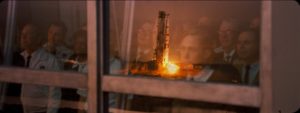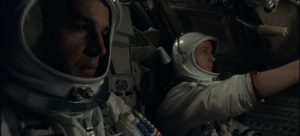Movie Info
Movie Info
- Director
- Damien Chazelle
- Run Time
- 2 hours and 21 minutes
- Rating
- PG-13
VP Content Ratings
- Violence
- 1/10
- Language
- 3/10
- Sex & Nudity
- 1/10
- Star Rating
Relevant Quotes
Safety first: Quarrying stones is dangerous. Be alert: Felling trees is hazardous.

And so is sitting atop a towering Saturn rocket dangerous, 20th Century’s space exploration proving as hazardous as the voyages of exploration in the days of caravels and galleons. Director Damien Chazelle’s film gives us the sense of being a passenger with the brave astronauts, as well it should, scriptwriter Josh Singer basing his script on the Best Selling NY Times book of the same name by aviation and space expert James R. Hansen. The film title is a shortened form of the book’s, which includes “The Life of Neil A. Armstrong.”

Thus, the film tells us as much about Neil Armstrong the family man as it does Armstrong the astronaut. The film begins in 1961 when Armstrong is a test pilot of an X-15 rocket plane. When he bounces off the surface of the atmosphere, it is suggested that he is distracted. Well he might be, as he and his wife Janet are dealing with their two-and-a-half-year-old daughter, Karen. The little one is undergoing treatment for a brain tumor. Despite all efforts to save her, she dies.
As his career develops, the family (they have a son) moving to Houston when Armstrong is chosen to participate in the space program, there will be other causes of grief—all related to the danger of the massive equipment and its explosive fuel. Two colleagues will die in a T-38 crash in 1965, and two years later the astronaut crew burns to death during the testing of the Apollo 1 system. The following year Armstrong himself is nearly killed while ejecting from the Lunar Landing Research Vehicle.
In addition to the danger, part of the pressure on Armstrong and his colleagues is that it really was a “space race,” with the Soviets thus far having racked up a number of “Firsts” in the race to the moon. (Indeed, it was by connecting the space program to Cold War competition that Congress and the American tax payers were convinced to support it.) Armstrong himself regarded the program from a more visionary perspective, saying,” I don’t know what space exploration will uncover, but I don’t think it’ll be exploration just for the sake of exploration. I think it’ll be more the fact that it allows us to see things. That maybe we should have seen a long time ago. But just haven’t been able to until now.”
In several crises we see the astronaut’s calmness saving the day, but this comes with a price because he keeps everything bottled up, much to Janet’s distress. She resents this, too often being treated by her husband’s friends in paternalistic ways. During one moment of danger Deke Slayton assures Janet, “We’ve got this under control.” Janet retorts,” You’re a bunch of boys making models out of balsa wood! You don’t have anything under control!”
Even when he has been chosen to lead the moon landing mission, Armstrong keeps his family at a distance. The night before blast-off he goes about packing his small suitcase without having sat down and talking with their children (they now have two sons). All too aware of the dangers, the angry Janet urges him to talk with the boys and inform them of the dangers and that he might not return. The older son Rick, aware that something is amiss, asks, “Mom, what’s wrong?” She sarcastically replies, “Nothing, honey. Your dad’s going to the Moon.” She says to her husband, “What are the chances you’re not coming back? Those kids, they don’t have a father anymore! So you’re gonna sit the boys down and prepare them for the fact that you might never come home!” And so he does.
There follows the tense mission itself on July 20, 1969, with Armstrong having to assume manual control of the descending module when boulders are discovered littering the intended landing spot. Then there is his stepping down and saying his simple but memorable declaration, “”That’s one small step for a man, one giant leap for mankind.” We sense there is a closure when he takes the little bracelet of his infant daughter and leaves it in Little West Crater.
This is a worthy film to add to The Right Stuff, not only reminding us of the dangers the brave astronauts faced, but also of the importance of the human element in the space program. Neil Armstrong and his colleagues were more than just passengers riding those giant, complex machines blasting toward the Moon, a view held by some of NASA’s engineers. There were several incidents in which their intervention staved off disaster. And they themselves were not just machines whose calmness enabled them to cope with the unexpected. They were family men, whose loved ones had to cope with the tension and fear inherent in their work. Ryan Gosling and the talented cast do a superb job in bringing the life and times of this man and his family to life. Like those who have served in our armed forces, they paid a price, but this film asserts it was worth it.
The special effects are first rate, living up to the high standards of the film that first set those standards, George Pal’s classic 1955 Destination Moon. Seeing the blue marble of Earth in the blackness of space underlines Neil Armstrong’s observation, “You’re down here and you look up and you don’t think about it too much. But space exploration changes your perception.”
This review will be in the November issue of VP along with a set of questions for reflection and/or discussion. If you have found reviews on this site helpful, please consider purchasing a subscription or individual issue in The Store.

